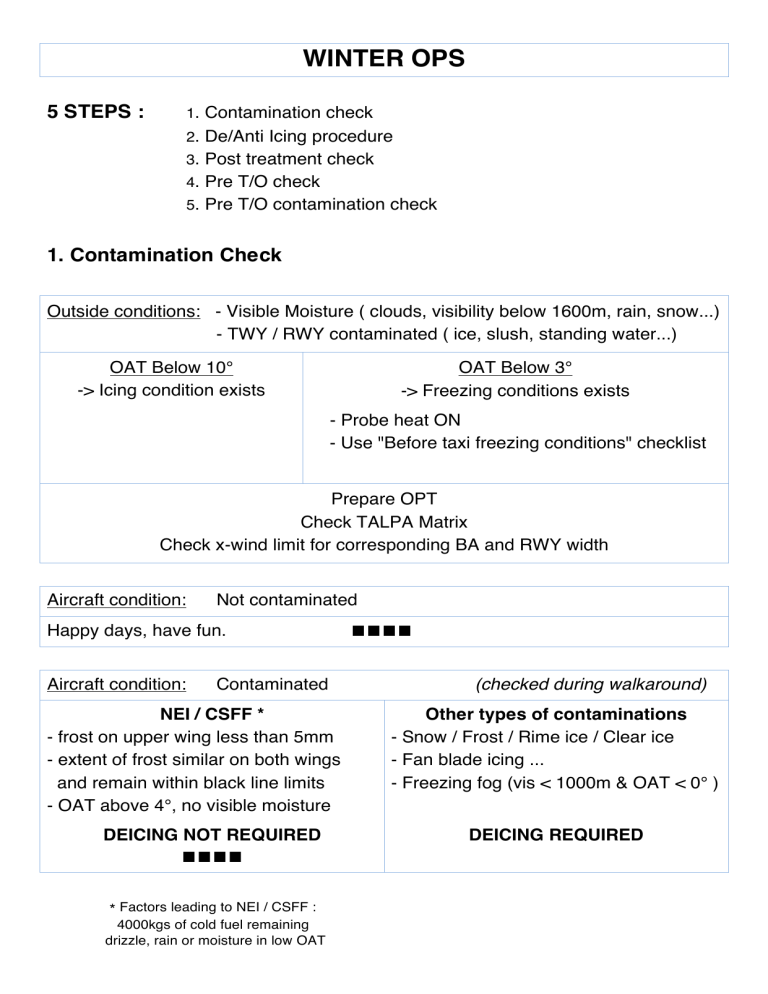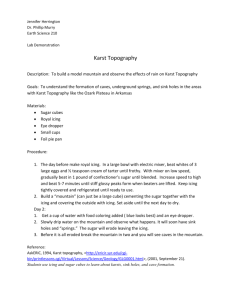
WINTER OPS 5 STEPS : 1. Contamination check 2. De/Anti Icing procedure 3. Post treatment check 4. Pre T/O check 5. Pre T/O contamination check 1. Contamination Check Outside conditions: - Visible Moisture ( clouds, visibility below 1600m, rain, snow...) - TWY / RWY contaminated ( ice, slush, standing water...) OAT Below 10° -> Icing condition exists OAT Below 3° -> Freezing conditions exists - Probe heat ON - Use "Before taxi freezing conditions" checklist Prepare OPT Check TALPA Matrix Check x-wind limit for corresponding BA and RWY width Aircraft condition: Not contaminated Happy days, have fun. Aircraft condition: Contaminated NEI / CSFF * - frost on upper wing less than 5mm - extent of frost similar on both wings and remain within black line limits - OAT above 4°, no visible moisture DEICING NOT REQUIRED ■■■■ * Factors leading to NEI / CSFF : 4000kgs of cold fuel remaining drizzle, rain or moisture in low OAT ■■■■ (checked during walkaround) Other types of contaminations - Snow / Frost / Rime ice / Clear ice - Fan blade icing ... - Freezing fog (vis < 1000m & OAT < 0° ) DEICING REQUIRED 2. De Icing Procedure PROCEDURE INFO De / Anti icing fluids - Type I : De Icing , Short Holdover , Orange - Type II : Anti Icing , Long Holdover , Translucent - Type III : not used , suitable for turboprops - Type IV : Anti Icing , Longer Holdover , Green One / Two step - One step is used to remove contamination and when no further icing is forecasted. - Two step is used to remove thick contamination and/or when icing conditions are forecasted prior takeoff. First step of hot water / diluted deicing fluid followed second step of less diluted anti icing fluid. - complete De/Anti Icing Request form - request tactile check if clear ice is suspected - establish if special de icing procedure is needed ( local area, fan blade ... ) - use lowest of OAT or wing skin temp to assess the mix of de/anti icing fluid - if the runway has been chemically treated, 2 step deicing is recommended - coordinate start of deicing to maximise HOT, check for delays ( CTOT ... ) Before Taxi Freezing Conditions Checklist Main differences: - PF accomplishes procedure / F/O completes checklist ( Read & Do ) - Engine anti ice ON - Wing anti ice ON (unless wing is protected by type II/IV or no bleed T/O is planned) - Flaps Up-40-Up When ready for taxi choose one: Deicing with engine running required - Clip winter ops handydandy to the yoke - Capt clips DAR to his yoke - Taxi to remote stand & deice - Complete "Deicing with engine running" Deicing not required or completed prior engine start - Clip winter ops handydandy to the yoke - Taxi to holding point - Complete checklist Both Checklists: (F/O) Challenge & Response -> (CPT) Action & Repeat Response Special considerations when taxiing: - Delay config check if flaps are kept up during taxi - Max 5kt on slippery or contaminated taxiways, avoid jet blast form other A/C - Static run up recommended every 30 min 3. Post treatement check · · · · · Obtain the de-icing code and record it in the ATL. HOT must be calculated by the Captain. No HOT applies to removal of local area contamination. Complete the DAR form with HOT and the de-ice service providers name if remote de-icing Clip the DAR form to the control column as a reminder for the pre-takeoff check. 4. Pre T/O check · Complete the Pre-takeoff check to validate the Holdover Time. · The DAR-01 form is removed from the control column and returned in the flight envelope. · If any doubt exists regarding the effectiveness of the anti-ice treatment or the HOT has expired: -> A Pre-takeoff Contamination check must be completed. 5. Pre T/O contamination check · Complete a visual inspection of the critical surfaces from within the cabin as described in OM A 8.2.4.5.6.5 and as described in Winter ops chapt 5. · If a re-treatment is necessary, any residue from the previous treatment should be removed with a hot mixed fluid followed by a completely new treatment. Cold temperature corrections - When OAT is at or below 0°C apply cold temperature altitude corrections for MFRA, MSA and also to SID stop altitudes if below the corrected MSA. - ATC must be advised and a clearance must have been received before climbing or descending to a Cold Temperature Corrected Altitude - Cold Temperature Altitude Corrections must be applied to DH/DA or MDH/MDA and step-down fixes inside and including the final approach fix (FAF) and missed approach altitudes. - Do not correct altitudes from the FAF to the MAPT in case of an APV approach. Observe minimum procedure temperature as stated on the chart. Other considerations: - Use of wing anti-ice above FL350 may cause bleed tripoff & cabin depressurisation - Holding in icing conditions with flaps extended is prohibited - Wing anti ice is usually not required at SAT below -40° - Jet A1 freezing point : -47° - Do not retract the flaps unless they are free of contaminants Run Up: ( 30s @ 70% N1 , Before T/O or every 30 min during taxi ) - PF "Timing" - PF advances thrust levers to 40% N1 - PM "Stabilised" - PF advances thrust levers to 70% N1 - PM observes no excessive vibrations/readings and calls "Stabilised" - PF releases brakes and pushes TOGA "Set T/O thrust"







